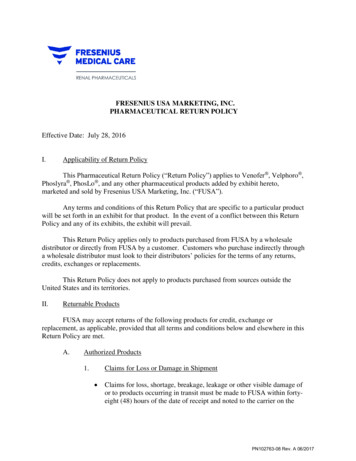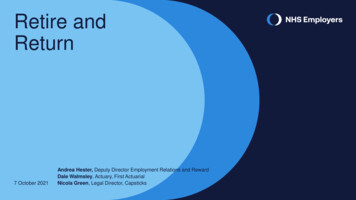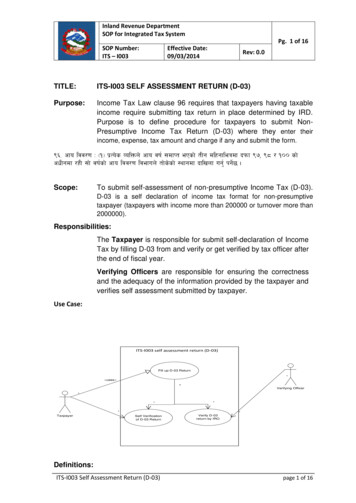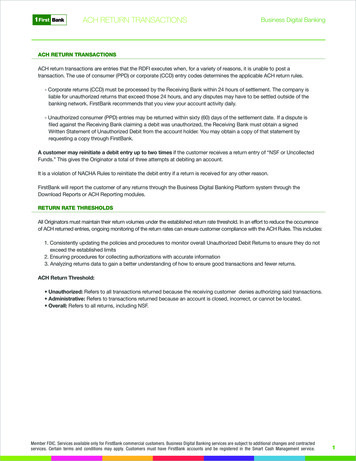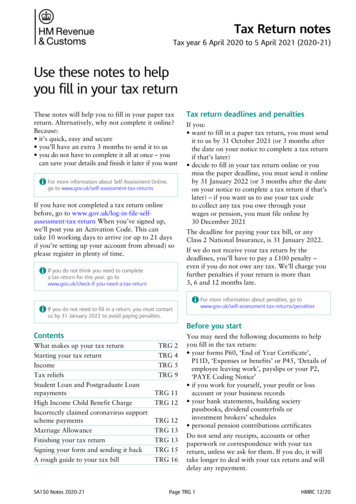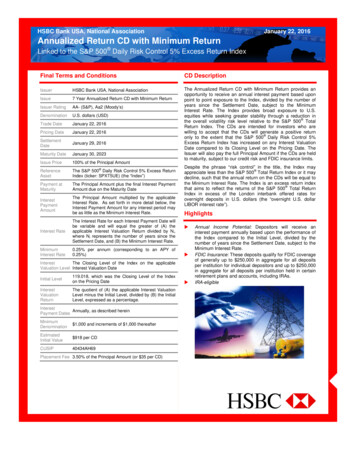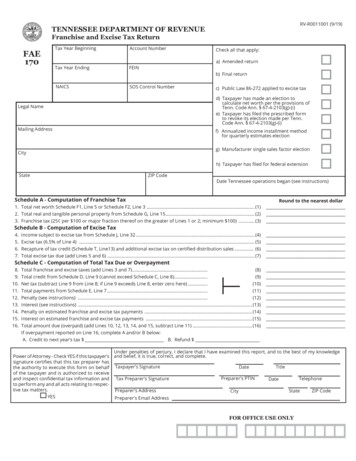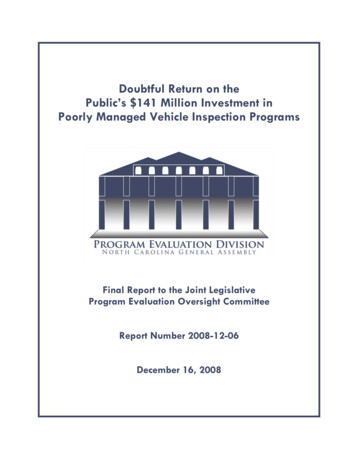
Transcription
Doubtful Return on thePublic’s 141 Million Investment inPoorly Managed Vehicle Inspection ProgramsFinal Report to the Joint LegislativeProgram Evaluation Oversight CommitteeReport Number 2008-12-06December 16, 2008
Program Evaluation DivisionNorth Carolina General AssemblyLegislative Office Building, Suite 100300 North Salisbury StreetRaleigh, NC 27603-5925919-301-1404www.ncleg.net/PED200 copies of this public document were printed at a cost of 601.52 or 3.00 per copy.A limited number of copies are available for distribution through the Legislative Library:Rooms 2126, 2226Room 500State Legislative BuildingLegislative Office BuildingRaleigh, NC 27601Raleigh, NC 27603919-733-7778919-733-9390The report is also available online at www.ncleg.net/PED.
NORTH CAROLINA GENERAL ASSEMBLYLegislative Services OfficeGeorge R. Hall, Legislative Services OfficerProgram Evaluation DivisionJohn W. Turcotte300 N. Salisbury Street, Suite 100Raleigh, NC 27603-5925Tel. 919-301-1404 Fax 919-301-1406DirectorDecember 1, 2008Representative James W. Crawford, Jr., Co-Chair, Joint Legislative Program Evaluation OversightCommitteeSenator Daniel G. Clodfelter, Co-Chair, Joint Legislative Program Evaluation Oversight CommitteeSenator Fletcher L. Hartsell, Jr., Co-Chair, Joint Legislative Program Evaluation Oversight CommitteeNorth Carolina General AssemblyLegislative Building16 West Jones StreetRaleigh, NC 27601Honorable Co-Chairs:The Program Evaluation Division 2007-2008 Work Plan, approved December 5th, 2007, directedthe Program Evaluation Division to evaluate the effectiveness and efficiency of the vehicle safetyand emissions inspection programs. This study examined how North Carolina operates and managesthe two vehicle inspection programs, and what impact these programs have on motorist safety andair quality.I am pleased to report that the Department of Transportation, the Department of Environment andNatural Resources, the Division of Motor Vehicles and the Division of Air Quality cooperated with usfully and were at all times courteous to our evaluators during the evaluation.Sincerely,John W. TurcotteDirectorAN EQUAL OPPORTUNITY/AFFIRMATIVE ACTION EMPLOYER
PROGRAM EVALUATION DIVISIONNORTH CAROLINA GENERAL ASSEMBLYDecember 2008Report No. 2008-12-06Doubtful Return on the Public’s 141 Million Investment inPoorly Managed Vehicle Inspection ProgramsSummaryThe Joint Legislative Program Evaluation Oversight Committee directed theProgram Evaluation Division to determine if the state’s vehicle safety andemissions inspection programs are effective and if the management andoversight of the programs are efficient.Vehicles registered in North Carolina are subject to two types ofinspections. Safety Inspection. An inspection of various mechanical systemsrequired by state law in all 100 counties of North Carolina forvehicles less than 35 years old. Emissions Inspection. An inspection utilizing the On BoardDiagnostic system for electronic readings to ensure properfunctioning of pollution controls for all 1996 and newer model yearvehicles. Only vehicles registered in 48 counties are subject to theemissions inspection.North Carolinians spend 141 million annually on inspections. It costs theDivision of Motor Vehicles (DMV) and the Division of Air Quality 40.8million to administer both inspection programs. The Program EvaluationDivision found no evidence exists showing the safety inspection program iseffective, it is not possible to determine how much vehicle emissions inspectionscontribute to the improvement of overall air quality, and program oversight by DMV is inadequate.In light of taxpayers’ and the state’s substantial investment in the inspectionprograms, the Program Evaluation Division recommends the North CarolinaGeneral Assembly reevaluate the need for a safety inspection program; consider exempting vehicles from the three newest model yearsfrom safety and emissions inspections; require DMV to manage the programs to ensure results by settingprogram goals, defining performance metrics, and reporting onprogress to these goals using data analysis; and direct the Fiscal Research Division to do a fiscal review of bothinspection programs to ensure efficiency and appropriateallocation of resources.
Vehicle Safety and Emissions InspectionsScopeReport No. 2008-12-06The North Carolina General Assembly’s Joint Legislative ProgramEvaluation Oversight Committee directed1 the Program Evaluation Divisionto determine if the state’s vehicle safety and emissions inspection programs areeffective and, if the management and oversight of the inspection programs isefficient.The North Carolina vehicle safety inspection program has been in existencefor 42 years and the emissions inspection program for 28 years. In late2008 and early 2009, several programmatic changes affecting bothprograms are scheduled to take effect. However, the efficacy of theinspection programs has not been independently reviewed since the mid1990s.The Program Evaluation Division collected and analyzed data from avariety of sources including 6.3 million inspection records from the Division of Motor Vehicles(DMV) Verizon database for Calendar Year 2007;2 vehicle registration data from the DMV State Titling andRegistration System database; interviews with the Department of Transportation’s DMV and theDepartment of Environment and Natural Resources’s Division of AirQuality management and personnel; interviews with other stakeholders including the State HighwayPatrol, the Independent Garage Owners of North Carolina, and theUniversity of North Carolina Highway Safety Research Center; review of relevant legislation, program and agency regulations,federal regulations, reports, and fiscal documentation; observations of actual safety and emissions inspections; interviews with administrators in other states; and reviews of other states’ safety and emissions inspection programs.BackgroundVehicles registered in North Carolina are subject to one of two types ofinspections. Safety Inspection. An inspection of various mechanical systemsrequired by state law in all 100 counties of North Carolina forvehicles less than 35 years old.3 Emissions Inspection. An inspection utilizing the On BoardDiagnostic system for electronic readings to ensure properfunctioning of pollution controls for all 1996 and newer model year1 The Joint Legislative Program Evaluation Oversight Committee establishes the Program Evaluation Division’s work plan in accordancewith N.C. Gen. Stat. § 120-36.13.2 The 6.3 million inspection records reviewed represent data from 48 counties. As of October 2008, DMV did not have the capacity tocollect inspection data electronically across all 100 counties. Inspection data collected in the 52 counties where the emissions test is notrequired is paper-based and, according to DMV officials, highly unreliable.3 N.C. Gen. Stat. § 20-183.2(a1).Page 2 of 27
Vehicle Safety and Emissions InspectionsReport No. 2008-12-06vehicles. Only vehicles registered in 48 counties are subject to theemissions inspection.4North Carolina is one of 16 states plus the District of Columbia with both asafety and an emissions inspection program. As a point of comparison,Exhibit 1 shows which states require no inspections, a safety inspection, anemissions inspection, or both. In North Carolina, the safety inspection andemissions inspection are two distinct programs; however, in emissionscounties, the two inspections are combined.In November 2008, three changes affecting the state’s safety inspectionprograms took effect. They include tying inspections to taxpayers’ registration renewals, discontinuing the use of paper windshield stickers to signify whethera vehicle is in compliance (E-sticker program), and increasing the cost of vehicle safety inspections by 4.50.By changing the inspection cycle to coincide with vehicle registration andautomating the collection of inspection data through the E-sticker program,the Division of Motor Vehicles (DMV) expects to increase inspectioncompliance for both inspection programs to 97%.5The Safety Inspection ProgramAs the availability and popularity of automobiles grew, so did regulationsregarding their operation and maintenance. In 1937, North Carolinapassed legislation describing minimum operating standards for vehicleequipment. In 1947, North Carolina established its first vehicle safetyinspection program requiring vehicle owners to submit their automobiles toannual safety inspections. However, the 1947 program was repealed in1949.The underlying assumption of the safety inspection program is that byidentifying mechanical defects and requiring their repair, the state iskeeping unsafe cars from operating on North Carolina roadways, therebyreducing loss of life and property damage. As cars evolved andmanufacturers focused on improved speed and performance, state andfederal officials grew increasingly concerned about the rate of injury,property damage, and death resulting from vehicle accidents. In the mid1960s, several pieces of federal and state legislation were passed toaddress these concerns. Among these efforts was the adoption of statesafety inspection programs.Counties are subject to an emissions inspection program based on the United States Environmental Protection Agency standards,population density, and other criteria. N.C. Gen. Stat. Chapter 143, Article 21B lists the North Carolina counties subject to emissionsinspections.5 Compliance is defined as the percentage of vehicles subject to inspection that complete a valid initial inspection. Division of AirQuality. (2007). North Carolina I/M Annual Report. See also Fiscal Research Division. (2007). Fiscal Note, Safety/emission inspectionchanges AB, HB 679 (5th ed.). Raleigh, NC: General Assembly. Current compliance rates for the safety-only and the emissions/safetyinspections are 81% and 94%, respectively. DMV system to wipe out inspection stickers. (2008, September 9). The Raleigh News &Observer, p. B1.Page 3 of 274
Exhibit 1: Safety and Emissions Inspections by esotaIdahoWyomingNevadaMaineNorth DakotaNebraskaUtahArizonaColoradoWisconsinSouth DakotaOklahomaNew MexicoTexasConnecticutPennsylvania New JerseyMissouriIndianaOhioWest orth CarolinaSouth CarolinaArkansasMississippiAlabamaAlaskaNew YorkMassachusettsMichiganIowaIllinoisKansasVermont New HampshireGeorgiaLouisianaFloridaNo Inspection (n 15)HawaiiSafety-Only Inspections (n 3)Emissions-Only Inspections (n 16)Safety and Emissions Inspections (n 16)Source: Program Evaluation Division based on states' web pages and data provided by the Division of Air Quality.
Vehicle Safety and Emissions InspectionsReport No. 2008-12-06In April 1965, Governor Dan Moore made an impassioned speech beforea joint session of the North Carolina General Assembly pushing for thepassage of a state safety inspection program. The General Assemblypassed House Bill 536, effective February 1966, laying the foundation fortoday’s vehicle safety inspection program. Exhibit 2 shows a timeline ofkey events in the evolution of national and state safety (and emissions)inspection laws.Exhibit 2: Evolution of Safety and Emissions Inspection ProgramsSource: Program Evaluation Division based on legislation and DMV documents.Today, vehicles less than 35 years old are subject to a vehicle safetyinspection in all 100 counties. The items subject to testing during a safetyonly inspection include6 brakes; lights (headlights, rear lights, stoplights); horn; steering mechanism; windshield wipers; directional signals; mirrors; exhaust emissions controls; and tires (added in 1969).A properly certified technician inspects vehicles at a state-licensedinspection station.7 The inspection procedures for both the safety-only andthe emissions inspection are detailed in Appendix A.According to industry representatives, the chief value of the safetyinspection program is that it compels motorists to annually assess the19A N.C. Admin. Code 03D. 0532-0542.Businesses wishing to operate as inspection stations—whether safety or emissions inspection stations—must apply for a license fromDMV and acquire appropriate equipment listed in DMV regulations. Technicians must complete eight hours of training to become asafety inspector, another eight hours to become an emissions inspector, and must receive a license from the state. One does not have tobe a mechanic in order to be a safety or emissions inspector. Certification courses are offered at a number of North Carolinacommunity colleges.Page 5 of 2767
Vehicle Safety and Emissions InspectionsReport No. 2008-12-06overall mechanical condition of their vehicles. The inspection programencourages preventative, holistic care versus addressing a specific issue orproblem only when it occurs.The Emissions Inspection ProgramThe passage of the federal Clean Air Act of 1970 added a new aspect tomotor vehicle regulation. The act and its subsequent amendments mandatedthat states—in cooperation with the federal government—monitor andregulate pollution levels, especially in designated “non-attainment” areasfor specified pollutants.8 The act directed the United States EnvironmentalProtection Agency (EPA) to set National Ambient Air Quality Standards forcriteria pollutants such as carbon monoxide, sulfur dioxide, nitrogendioxide, total photochemical oxidants, total suspended particles, andhydrocarbons. In 1997, the National Ambient Air Quality Standards wererevised to include fine particulate matter. In North Carolina, the chiefmobile source pollutants include carbon monoxide as well as nitrogenoxides and hydrocarbons (both of which lead to the creation of ozone).Depending on the level of non-attainment, the EPA permits states todetermine how best to meet federal standards. States file a StateImplementation Plan detailing how they plan to meet those standards. TheState Implementation Plan includes air quality standards that apply tostationary as well as mobile sources and outlines the state’s overallstrategy for monitoring and mitigating pollutant levels. The mobileemissions program, of which the vehicle emissions inspection is one facet, ispart of the Division of Air Quality’s broader program for improving airquality in North Carolina.9The Clean Air Act requires areas designated as having a moderate levelof pollution implement a vehicle emissions program. Seven counties in NorthCarolina have been designated by the EPA as moderate: Gaston,Mecklenburg, Cabarrus, Iredell (partial), Lincoln, Rowan, and Union. Anadditional 41 counties are part of the emissions inspection programbecause the Division of Air Quality deemed participation in the inspectionprogram as necessary to meet clean air standards.10 These counties werechosen based on their population and traffic volume. Senate Bill 953,passed in July 1999, stipulated counties with more than 40,000 peopleand daily vehicle miles traveled of more than 900,000 are subject toparticipation in the emissions inspection program.11North Carolina’s first vehicle emissions inspection program was establishedin Mecklenburg County in the early 1980s. The early emissions inspectionprogram relied on a tailpipe test to determine which cars were releasingexcess pollution. The tailpipe test was administered by inserting a probe8 A non-attainment area is a geographic area in which the level of an air pollutant is higher than the level allowed by federalstandards. A single geographic area may have acceptable levels of one air pollutant but unacceptable levels of another. Thus, an areacan be both an attainment area and a non-attainment area at the same time. National Research Council. (2001). Evaluating vehicleemissions inspection and maintenance programs. Washington, DC.9 The air quality program is a balance of tradeoffs. For example, if the state relaxed mobile source program requirements, the Divisionof Air Quality would have to modify the State Implementation Plan by creating more stringent stationary source controls.10 The Division of Air Quality uses modeling to estimate the amount of pollutants resulting from various sources. This modeling data isthen used to help the Division of Air Quality create the State Implementation Plan and design programs to improve air quality.11 1999 N.C. Sess. Laws, 1999-328 § 3.1(d).Page 6 of 27
Vehicle Safety and Emissions InspectionsReport No. 2008-12-06into a car’s tailpipe and measuring the amount of pollution emitted.However, the tailpipe test could not identify which component of thevehicle’s exhaust control system was causing problems. The tailpipe testwas discontinued in December 2005 because it had become obsolete.As a result of regulatory changes associated with the Clean Air Act, NorthCarolina adapted its emissions inspection program to use the On BoardDiagnostic (OBD) test instead of the tailpipe test.12 The OBD test isconducted by hooking up a vehicle to an analyzer machine via a cable thatdownloads diagnostic information from a car’s onboard computers. Theunderlying assumption of the modern emissions inspection program is aslong as a vehicle’s onboard diagnostic systems are functioning properlyand the OBD systems do not indicate an emissions problem, then a vehicleis not releasing excess pollutants.North Carolina’s transition from the tailpipe test to the OBD test to monitoremissions began in 2002, and the emissions inspection program wasexpanded to 48 counties by the end of 2006. Vehicles model year 1996and newer are equipped with OBD systems designed to monitor emissionsrelated components.13 Therefore, only model year 1996 and newervehicles in 48 counties are subject to the emissions inspection. Exhibit 3depicts North Carolina counties with emissions inspection programs andthose having safety-only inspection programs.North Carolina has made strides in attaining and maintaining the ozonestandards established in 1997 in the face of population growth andincreased vehicle traffic. Whereas the state once had all or parts of 32counties designated as non-attainment areas for ozone, today only theCharlotte area’s ozone levels are too high.14The emissions inspection program is managed by DMV, which is responsiblefor the day-to-day operation of the program and various oversightactivities (e.g., licensing of stations, audits, enforcement). The Division of AirQuality is responsible for the overall design of the state’s air qualitystrategy and audits DMV’s management of the program. The two divisionshave a memorandum of understanding delineating roles andresponsibilities. The management of the emissions program is discussed onpage 12.The emissions inspection is enforced by registration denial, which wasinitiated in 1999. Registration denial requires DMV to match electronicregistration records with electronic emissions inspection records todetermine which registered vehicles have submitted to inspections and havepassed. Vehicles that either have not undergone an inspection or have notpassed are unable to obtain registration.In this report the use of the term OBD, unless otherwise specified, refers to the OBD II test used to complete the emissions inspection.A dashboard-mounted malfunction indicator lamp illuminates to alert the driver of malfunctions or deterioration.14 In 2008, the EPA once again made the standard for ozone more stringent. As a result, the Division of Air Quality anticipates moreareas of the state will be designated as non-attainment areas under the new standard.Page 7 of 271213
Exhibit 3: Safety and Emissions Inspections by CountyAsheWataugaMitchellAveryMadison okes Rockingham Caswell PersonVance akeNashGatesCamden rrellMcDowellCatawbaRowanHaywood andJacksonMontgomeryStanlyPolkGaston keePamlicoClayJonesHoke Cumberland SampsonUnionAnson enderColumbusNew HanoverBrunswickSafety-Only Inspections (n 52)Safety and Emissions Inspections (n 48)Source: Program Evaluation Division based on information provided by the Department of Transportation.HydeDare
Vehicle Safety and Emissions InspectionsReport No. 2008-12-06Cost of Inspection ProgramsThe current safety-only inspection costs 13.60,15 with 12.75 beingretained by the inspection station and 0.85 going to the state.Comparatively, the emissions inspection costs 30 dollars, with 23.75being retained by the inspection station and 6.25 going to the state. Thecost of the inspections is determined by the General Assembly and iscodified in statute. Exhibit 4 shows the number of vehicles subject to safetyand emissions inspections.Exhibit 4Registered VehiclesSubject to Safety andEmissions Inspections inCalendar Year 2007Vehicle ModelYear1995 and older1996 and newerTotal48 Emissions Counties52 Non-Emissions Counties1,321,463 vehicles subjectto safety-only inspection3,959,068 vehicles subjectto emissions inspection344,356 vehicles subject tosafety-only inspection756,257 vehicles subject tosafety-only inspection5,280,531 vehicles subjectto inspection1,100,613 vehicles subject toinspectionNote: All model years does not include vehicles with missing county information.Source: Program Evaluation Division based on DMV registration data.Based on the number of vehicles subject to inspection, the ProgramEvaluation Division estimated North Carolinians spend 141 million peryear on vehicle inspections. Exhibit 5 shows what portion of the 141million is retained by the state and what amount goes to inspection stations.Exhibit 5Distribution of the Public’s 141 Million Spent onInspection ProgramsBetween InspectionStations and the StateInspectionStations, 114,009,99281%State, 26,802,94019%Source: Program Evaluation Division based on inspection costs and DMV data.In addition to the price of the inspection, motorists also incur other costsassociated with getting an inspection. Travel time, wait time, and timeaway from work or other activities are costs incurred by individuals whomust get a vehicle inspection. The Program Evaluation Division estimates theindirect costs associated with getting an emissions inspection areapproximately 21 million.16In November 2008, the safety inspection fee was raised from 9.10 to 13.60, nearly a 50% increase. The 4.50 increase will goto inspection stations.16 For this calculation, the Program Evaluation Division assumed it takes half an hour to drive to and from an inspection station, wait inline, and get an inspection done. The value of half an hour of a person’s time was set at 3.28, or half of North Carolina’s hourlyminimum wage ( 6.55). The 6,381,144 vehicles subject to inspection was multiplied by 3.28 to arrive at 20,930,152 as the indirectcost of inspections to North Carolinians.Page 9 of 2715
Vehicle Safety and Emissions InspectionsReport No. 2008-12-06Exhibit 6 shows how the state’s portion of the safety and emissionsinspection fees is distributed. In Fiscal Year 2007-08, the state’s portion ofthe inspection fees totaled more than 30 million— 27.3 million fromemissions inspections and 2.9 million from safety inspections. Inspectionstations receive 12.75 and the state receives 0.85 for each safetyinspection performed. Meanwhile, inspection stations receive 23.75 andthe state receives 6.25 for each emissions inspection performed. For eitherinspection type, the state’s portion is further subdivided among variousaccounts as depicted in Exhibit 6.Exhibit 6: Distribution of Inspection Fees as of November 2008Distribution of 13.60 Safety Only Inspection FeeHighway Fund, 0.55NC, 0.85Volunteer Rescue/EMSFund, 0.18Rescue Squad WorkersRelief Fund, 0.12Inspection Stations, 12.75Distribution of 30 Emissions Inspection FeeHighway Fund, 0.55Emission Program Account, 3.00NC, 6.25TelecommunicationsAccount, 1.75Volunteer Rescue/EMSFund, 0.18Inspection Stations, 23.75Rescue Squad WorkersRelief Fund, 0.12Division of Air Quality, 0.65Source: Program Evaluation Division based on fees listed in N.C. Gen. Stat. §20-183.Page 10 of 27
Vehicle Safety and Emissions InspectionsReport No. 2008-12-06The distribution of state fees collected from the safety and emissionsinspection programs is mandated by law.17 Revenues from the inspectionprograms go to the following funds: Highway Fund. The Highway Fund provides funding for roadmaintenance, DMV, and other transportation programs andservices. The Highway Fund receives 0.55 from every safety andemissions inspection. In Fiscal Year 2007-08, the fund receivednearly 4.3 million. Telecommunications Account. From each emissions inspection, 1.75 goes to the Telecommunications Account, which was createdas a non-reverting account within the Highway Fund. In Fiscal Year2007-08, the account received 7.6 million from inspectionrevenue. This account pays for the hardware, software, andcommunications costs for inspection stations to interface with thestate. Of the 1.75, 1.30 covers current data transmittal betweeninspection stations in the 48 counties and the state. The remaining 0.45 has been held in reserve to pay for the automation of theremaining 52 counties, which includes the purchase ofapproximately 3,000 analyzer machines provided to stations bythe state. As of November 2008, 0.05 of the 1.75 is held inreserve to pay for future program enhancements; 0.05 equates toapproximately 2 million reserved per fiscal year.18 Volunteer Rescue/EMS Fund. Created within the Department ofInsurance, this fund provides grants for equipment and capitalimprovements to volunteer rescue and Emergency Medical Servicessquads. The fund, which receives 0.18 from every safety andemissions inspection, is resourced wholly by the inspection programs.In Fiscal Year 2007-08, the fund received a total of 1.4 million. Rescue Squad Workers’ Relief Fund. This fund receives 0.12 fromevery safety and emissions inspection. Revenues credited to thisaccount fund over 400 scholarships and provide financial supportfor rescue and Emergency Medical Services personnel and theirdependents. This account is funded completely by revenue frominspection fees, which in Fiscal Year 2007-08 totaled over 924,000. Emissions Program Account. This account was created as a nonreverting account within the Highway Fund and receives 3 fromevery emissions inspection. DMV administers the account and mayonly use it to fund the emissions inspection program. In Fiscal Year2007-08, the account received 13 million from inspection fees. Division of Air Quality. The Division of Air Quality receives 0.65from every emissions inspection. Revenues are used to pay forauditing and management of the emissions program. In Fiscal Year2007-08, the account received 2.8 million from the inspectionprogram.N.C. Gen. Stat. § 20-183.7.This amount is based on the 3,959,068 vehicles subject to emissions inspection in the 48 emissions counties in Calendar Year 2007multiplied by 0.05, which equals 1,979,534.Page 11 of 271718
Vehicle Safety and Emissions InspectionsReport No. 2008-12-06Funding for the safety inspection program is appropriated by the GeneralAssembly and is part of DMV’s License and Theft Bureau’s 20.8 millionoperating budget. The budget includes 343 employees—88 of whom areinvolved in the enforcement of the safety inspection program. Fundsappropriated for the License and Theft Bureau that are not used by theend of the fiscal year revert back to the Department of TransportationHighway Fund. Unlike the safety-only inspection program, the emissionsprogram is a receipt-based program, meaning money generated throughthe inspection fee covers personnel and operating costs.In Fiscal Year 2007-08, it cost DMV 17.8 million to operate the emissionsprogram. The DMV emissions budget pays for 61 emissions specialists and61 emissions inspectors in addition to covering program administrationcosts. DMV emissions inspection program funds not used by the end of thefiscal year remain in DMV’s emissions program account. For example, forFiscal Year 2007-2008 DMV had budgeted 30 million for the emissionsinspection program. However, at the close of the fiscal year, DMV showedan available budget of 13 million in the emissions inspection programaccount.During the same fiscal year, it cost the Division of Air Quality 2.2 millionto run its portion of the emissions inspection program. Revenues accrued tothe Division of Air Quality from the emissions inspection program pay for seven auditors to audit DMV, program administration, and outreach and education.The Division of Air Quality currently has a 3.6 million balance in itsemissions inspection program account. The Division of Air Quality plans touse this balance to support aspects of its mobile source program such asambient monitoring, modeling, transportation planning, and infrastructure.Program ManagementNorth Carolina is one of 20 states operating a decentralized safety andemissions inspection program.19 A decentralized program was adopted inNorth Carolina because it was seen as more convenient for the public (e.g.,easier access, greater choice).20 The state sets policies and procedures forthe conduct of the inspection programs and provides oversight, butprivately owned and operated facilities actually do the inspections.As illustrated in Exhibit 7, DMV’s License and Theft Bureau is responsible forthe oversight and regulation of both the safety and emissions inspectionprograms. DMV oversees the network of inspection stations that performboth types of inspections. Due to federal requirements, the emissionsinspection program is ha
Exhibit 1: Safety and Emissions Inspections by State Al ask Hawaii Source: Program Evaluation Division based on states' web pages and data provided by the Division of Air Quality. No Inspection (n 15) Safety-Only Inspections (n 3) Emissions-Only Inspections (n 16) Safety and Emissions Inspections (n 16)



